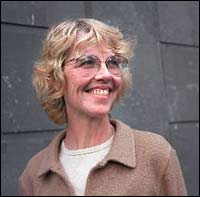Better than hell

|

|
“Everyone has heard of hell,” quips a T-shirt comparing hell favorably to the University. Like many jests, it contains a grain of truth. “We know from multiple studies that we are relatively unknown,” Vice President for University Relations and Dean of College Enrollment Michael Behnke said at Wednesday’s town-hall meeting, “Telling the University’s Story: How We Attract Students and Educate the Public.” For instance, a McKinsey survey of top SAT-scoring high-school seniors found that while half were “knowledgeable” about Yale—meaning that they knew “a lot” or “a fair amount” about the school—and two percent had never heard of it, only 22 percent felt knowledgeable about Chicago. 14 percent were unaware of its existence.
Why is Chicago—with its plethora of Nobel laureates, prestigious programs, and a seventh-in-the-nation ranking for producing science and engineering PhDs—so little recognized? Its location in the Midwest, a “fly-over zone” for people on the coasts, and its name—long, not catchy, in its full form mistaken for the University of Illinois at Chicago and, when shortened to the U of C, confused with the Universities of Connecticut and California—may be partly to blame, along with its not being a Big Ten or Division I school. “We’re also unapologetically intellectual in an anti-intellectual country,” Behnke said, and “don’t cater to the rich and famous.” The lack of news coverage, he added, doesn’t help. A 2004 study of 20 major U.S. publications, conducted by Chicago PR firm Lipman Hearne, found 76 Chicago mentions, trailing Harvard at 302, Michigan at 160, and Yale at 111; moreover, 81 percent of University news coverage was in the Midwest. Behnke hopes to combat this lack of coverage by developing the University’s communications and long-range plans in four key areas: the re-bid for Argonne National Laboratory; urban education; the arts; and diversity.
Since 1997 Chicago—with Behnke leading the charge—has striven to attract more, high-quality applicants to the College via aggressive outreach and recruiting efforts, such as direct mailings to high-schoolers and the Collegiate Scholars Program. The results have been striking. Between 1998 and 2005, applications shot up 64 percent, with early-action applications increasing by 43 percent, and the average SAT score rose from 1349 to 1428. African American and Latino enrollment numbers remain low—54 and 94 for the incoming class, respectively—but increasing and retaining minority enrollees, Behnke emphasized, are a top priority.
Hana Yoo, ’07
Photos: Behnke and his survey results.




















